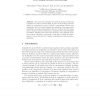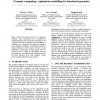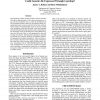954 search results - page 17 / 191 » Principles and Models for Organizing the IT Function |
ICPR
2008
IEEE
14 years 8 months ago
2008
IEEE
In kernel density estimation methods, an approximation of the data probability density function is achieved by locating a kernel function at each data location. The smoothness of ...
CALCO
2009
Springer
14 years 2 months ago
2009
Springer
The microcosm principle, advocated by Baez and Dolan and formalized for Lawvere theories lately by three of the authors, has been applied to coalgebras in order to describe composi...
GECCO
2000
Springer
13 years 11 months ago
2000
Springer
Many newly discovered genes are of unknown function. DNA microarrays are a method for determining the expression levels of all genes in an organism for which a complete genome seq...
CSCW
2008
ACM
13 years 8 months ago
2008
ACM
Assistance – work carried out by one entity in support of another – is a concept of long-standing interest, both as a type of human work common in organizations and as a model...
AAAI
2000
13 years 9 months ago
2000
Self-organizing models develop realistic cortical structures when given approximations of the visual environment as input, and are an effective way to model the development of fac...



